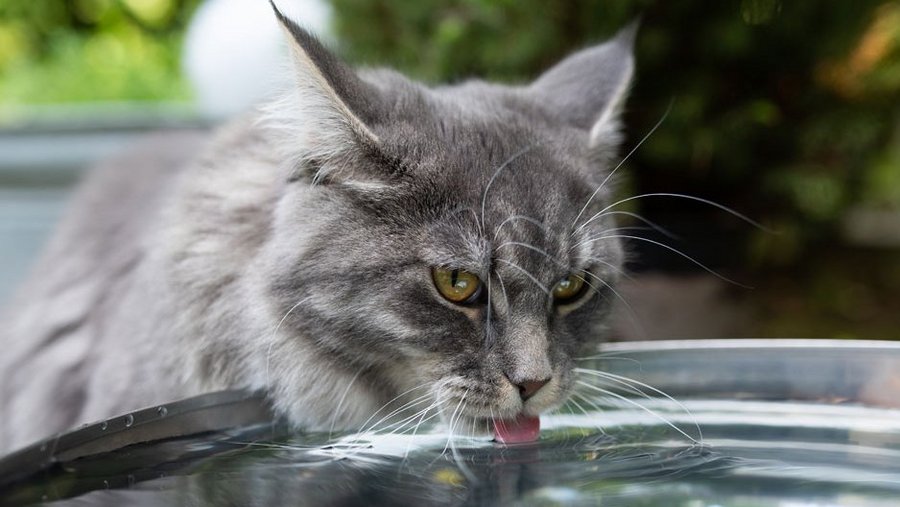Cats can be fussy when it comes to drinking. This is because of the supply. With these tips, you can make water more palatable for your cat.
An indoor cat weighing about 4.5 kg should drink up to 210 ml of water per day. If you feed your cat only wet food, it can almost cover its needs. But with increased activity or when given dry food, the need increases. If your cat does not drink enough fluids, it may develop urinary stones and kidney problems.
Tip: 1 The right place to drink
For many cats, the problem begins with the choice of where to drink. What many owners don’t know: Cats don’t like to drink where they eat. They instinctively fear that the water may be contaminated with food debris. So don’t place the water bowl right next to the food bowl. Your cat also doesn’t want the litter box near their water bowl. In addition, the drinking bowl should be in a quiet place. Stress and noise is not something your feline likes when it comes to water intake.
Tip: 2 Plenty of opportunities to drink
You should ideally distribute several vessels at different places in the house. You can also set them in places where your cat often walks by. If your cat does not accept certain places, you can try placing the bowls somewhere else. Once it has accepted one or two places, you can put the other bowls away.
Tip: 3 The right bowl
Cats have different preferences for how they drink. Some prefer shallow, wide bowls because they don’t like bumping their whiskers on the edges. Others prefer to drink from tall vases. Offer your cat a variety of vessels. And pay attention to the material. Metal, glass, and ceramic are fine. Some cats do not like plastic because it is not completely odourless. It bothers their delicate noses. Some cats love it when the water moves. Therefore, they often drink from the tap as well. They will be even more pleased with a drinking fountain. Again, you should opt for a model made of ceramic rather than plastic. Many models have an activated carbon filter that keeps the water fresh and clean at all times. Nevertheless, you must clean the fountain regularly. Otherwise, films of bacteria and algae will quickly form.
Tip: 4 It all depends on the right water
Even when it comes to the quality of the water, cats have different dispositions. You can roughly distinguish between two types: the freshness fanatics and the “puddle drinkers”. Some will jump at the bowl as soon as you put fresh water down. Others prefer water that has been sitting around for a few days. Basically, most cats are sensitive to chlorine in water. You should therefore let fresh tap water stand in a jug for at least two hours. Possibly even boil it briefly and then serve it cooled down. For the “puddle drinkers”, you can let the water stand for several days. However, you should normally change the water every day and keep the containers clean. Because your cat carries food remains and bacteria into the water. Not very tasty and not really healthy.
Tip: 5 Sneak in some water
You can also mix a few tablespoons of water into your cat’s food at every meal. Mixed well, many are happy about the extra portion of moisture. For a cat who resist wet feed, you can try soaking dry feed in water to see if it will accept this. If your cat can’t be convinced to change food and drinks poorly, you have to go to “Trick 17”. That’s because a daily ration of dry food contains only about 6 ml of liquid on average. So you have to motivate your pet to drink at least 200 ml of water a day.
Tip: 6 Use “Trick 17”
You can use various tricks to make drinking more appealing to cats who are particularly shy of water. For example, with diluted cat milk or home-cooked (unflavoured!) meat or fish broth. Here you can experiment with how much cat milk or broth you have to add in order to get your cat to drink. You can freeze the broth into ice cubes. Some cats like to lick these (especially in the heat) or find the water bowl incredibly interesting as soon as there is such an ice cube floating in it. Finally, you can also try out whether your cat is simply annoyed because it does not recognise the water level and has dived in too often with its nose. Put a blade of grass on the surface. This little trick sometimes works wonders.
So many options – where to start? As a general rule: Observe your cat, keep what works well, and simple leave out everything that doesn’t work. With a little attention and experimentation, your cats will become habitual drinkers too. It’s worth it because you can save them from typical cat ailments.

